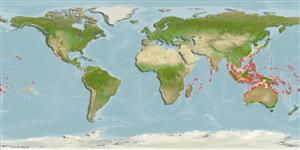>
Blenniiformes (Blennies) >
Tripterygiidae (Triplefin blennies) > Tripterygiinae
Etymology: Helcogramma: Greek, helkos, -eos, -ous = ulcer, sore + Greek, gramma = letter, mark (Ref. 45335).
More on author: Rosenblatt.
Environment: milieu / climate zone / depth range / distribution range
Ecologia
marinhas associadas(os) a recifes; intervalo de profundidade 0 - 32 m (Ref. 13227), usually ? - 10 m (Ref. 6211). Tropical
Indo-West Pacific: Sri Lanka, including Cocos-Keeling Islands and Christmas Island, to Thailand then Japan, the Phoenix and Marshall Islands and American Samoa, also Fiji.
Tamanho / Peso / Idade
Maturity: Lm ? range ? - ? cm
Max length : 3.1 cm SL macho/indeterminado; (Ref. 13227)
Descrição suscinta
Chaves de identificação | Morfologia | Morfometria
Espinhos dorsais (total) : 19; Raios dorsais (total) : 9 - 12; Espinhos anais: 1; Raios anais : 18 - 20.
Adults inhabit surge zones of exposed reefs (Ref. 1602), on rock surfaces and under ledges (Ref. 13227). Eggs are hemispherical and covered with numerous sticky threads that anchor them in the algae on the nesting sites (Ref. 240). Larvae are planktonic which occur primarily in shallow, nearshore waters (Ref. 94114).
Ciclo de vida ou comportamento de acasalamento
Maturities | Reprodução | Spawnings | Egg(s) | Fecundities | Larvas
Fricke, R., 1994. Tripterygiid fishes of Australia, New Zealand and the southwest Pacific Ocean (Teleostei). Theses Zool. 24:1-585. (Ref. 13227)
Status na Lista Vermelha da UICN (Ref. 130435)
Ameaça para os humanos
Harmless
Uso pelos humanos
Pescarias: sem interesse
Ferramentas
Relatórios especiais
Baixar XML
Fontes da internet
Estimates based on models
Preferred temperature (Ref.
123201): 25.1 - 29.3, mean 28.5 °C (based on 2882 cells).
Índice de diversidade filogenética (Ref.
82804): PD
50 = 0.5000 [Uniqueness, from 0.5 = low to 2.0 = high].
Bayesian length-weight: a=0.00562 (0.00258 - 0.01228), b=3.08 (2.89 - 3.27), in cm total length, based on LWR estimates for this (Sub)family-body shape (Ref.
93245).
Nível Trófico (Ref.
69278): 3.0 ±0.3 se; based on size and trophs of closest relatives
Resiliência (Ref.
120179): Elevada, tempo mínimo de duplicação da população menor que 15 meses (Preliminary K or Fecundity.).
Fishing Vulnerability (Ref.
59153): Low vulnerability (10 of 100).
Nutrients (Ref.
124155): Calcium = 571 [200, 2,589] mg/100g; Iron = 3.15 [1.09, 7.71] mg/100g; Protein = 17.9 [16.1, 19.8] %; Omega3 = 0.106 [0.022, 0.525] g/100g; Selenium = 78.2 [13.0, 380.6] μg/100g; VitaminA = 53.6 [7.0, 417.9] μg/100g; Zinc = 5.77 [2.43, 11.32] mg/100g (wet weight);
